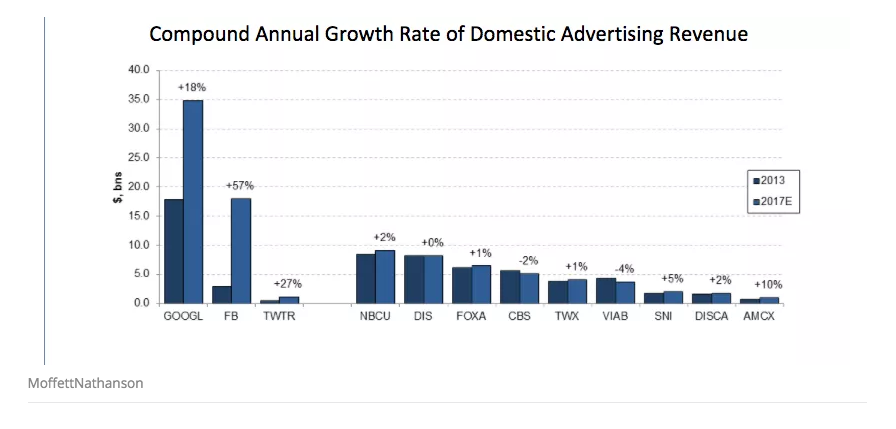There’s no doubt that linear advertising revenues are going to decline in the coming years for big networks.
Squeezed by Facebook and Google on one side, and impossible consumer expectations created by Netflix, Amazon and other streaming services on the other, the idea of an ad-supported entertainment business is under siege.
This chart from the analyst firm MoffettNathanson shows just how grim the situation is for companies not named Google or Facebook.

But in a wide-ranging conversation at the Code Media conference in Huntington Beach, Calif., the top executives of Turner and A+E Networks elaborated on how their app businesses and investments in startups are driving new growth.
While it’s not a revelation that apps are a great way to make money and build a deeper relationship with consumers, and that technology is the future for networks (frankly the tech companies that have overrun Hollywood in the past few years are a stark example of this new reality), the success of Turner’s Boomerang service and the investments that A+E has made in companies like Atlas Obscura and Vice highlight alternative ways to make money (I’m also looking at you, Vox and Recode).
Turner launched Boomerang last year as a subscription service for cartoons in a joint venture between Cartoon Network and Warner Brothers. The app now counts roughly 150,000 subscribers, according to Turner chief executive John Martin. Martin also said the company was seeing success with its FilmStruck service, which leverages the Turner Classic Movies brand to offer a curated slate of movies to watch.
Martin said FilmStruck “provides a learning experience into what the future of this business is going to be, which is tapping into fandom.”
For Martin, the idea of curation is going to be increasingly important as the amount of available distractions and stories explodes across different media properties. If the future of Turner is, as Martin says, “being responsible for controlling the consumer experience from start to finish,” then guiding people to apps where Turner can control that experience just makes sense.
Meanwhile, A+E has leveraged its investments in Atlas Obscura and Vice to provide new types of marketing dollars and open the network to an entirely new audience, according to chief executive Nancy Dubuc.
Dubuc pointed to the company’s investment in Atlas Obscura as being a great way to move its audience from television at the History Channel, through Atlas Obscura to experiential marketing campaigns for a credit card company like American Express that would give benefits to new applicants.
Dubuc also said that Vice Media has been a success for the company. “Vice came to be around converting a channel so that you can reach a millennial audience,” Dubuc said of the A+E decision to convert its H2 channel over to Viceland.
“They have the second most upscale audience to Bravo,” Dubuc says of the Viceland channel. While the channel hasn’t seen tremendous subscriber growth, it’s reaching an audience of 18-34-year-old males with household incomes over $60,000, she said.
Those numbers will appeal to any marketer.
Nor are the two networks alone in looking to technology for returns. According to people with knowledge of the situation, that’s one of the reasons why Fox bought TrueX four years ago — to improve the experience for consumers watching ads online.
“Putting aside the investments in other companies, it’s about having deep relationships with consumers however you get there,” says one technology exec at a major studio. “Having an app on somebody’s phone is perhaps the best way to get there… There’s a fundamental thesis there. In today’s world you not only have to think about being broad you have to think about being deep too.”
